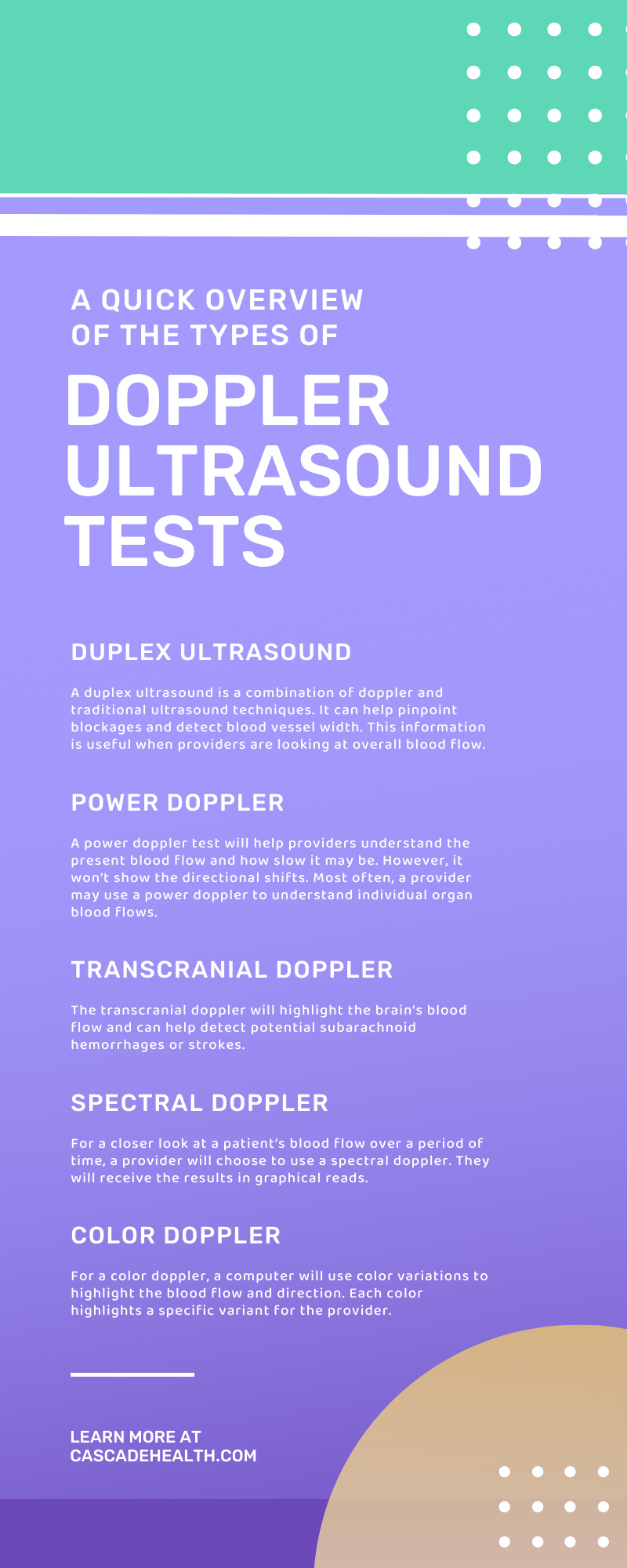A Quick Overview of the Types of Doppler Ultrasound Tests
While receiving active antenatal care, there may be a variety of reasons for your overseeing health provider to run additional testing, scans, or bloodwork. A lot of things are precautionary. Remember to trust your doctor and their experience and knowledge any time they decide to run extra screenings.
One of these screenings may be a doppler ultrasound test. These scans help highlight any reason for concern or question while pregnant and help paint a bigger picture for the healthcare provider. Specifically, a doppler ultrasound can help a provider understand the mother’s blood movement and supply, and this information can detect many heart-related concerns. Here, we explain the doppler ultrasound in more detail to help you understand all the reasons for it.
Doppler Ultrasound Explained
The doppler ultrasound is a beneficial tool to help detect potential blood vessel- or heart-related concerns. These scans highlight blood flow direction and how the blood supply interacts with various veins and arteries. Things like blood clots, narrow artery passages, and other heart-related issues are detectable on the scan as well.
How Does a Doppler Ultrasound Work?
These devices use a combination of sound waves to create digital imagery of the blood flow and supply through a patient’s circulatory system. The image will show the medical provider the direct path of the blood, in addition to the speed at which it travels through major veins and arteries.
Another primary component of this imagery is the detection of blood flow through a patient’s heart. These results help medical providers identify and diagnose any potential blood- or heart-related concerns during pregnancy.
Different Types of Doppler Ultrasound
There are a variety of ultrasound techniques and purposes, and each type is noninvasive. While a standard ultrasound will produce internal imagery, it won’t showcase any of the blood supply or flow. This is where a doppler ultrasound is the most effective device available. For doppler ultrasounds, there are a few types that a provider can use, including:
- Duplex Ultrasound. A duplex ultrasound is a combination of doppler and traditional ultrasound techniques. It can help pinpoint blockages and detect blood vessel width. This information is useful when providers are looking at overall blood flow.
- Power Doppler. A power doppler test will help providers understand the present blood flow and how slow it may be. However, it won’t show the directional shifts. Most often, a provider may use a power doppler to understand individual organ blood flows.
- Transcranial Doppler. The transcranial doppler will highlight the brain’s blood flow and can help detect potential subarachnoid hemorrhages or strokes.
- Spectral Doppler. For a closer look at a patient’s blood flow over a period of time, a provider will choose to use a spectral doppler. They will receive the results in graphical reads.
- Color Doppler. For a color doppler, a computer will use color variations to highlight the blood flow and direction. Each color highlights a specific variant for the provider.
Who Benefits From Doppler Ultrasounds?
The use of doppler ultrasound varies based on medical need and chosen provider. Most often, a doppler is the go-to for situations where the provider wants to learn a few things:
- The flow of blood between a mother and her baby while in the womb.
- Monitoring blood flow in a post-operative state.
- Diagnose and treat certain blood disorders that may affect the arms, legs, or abdomen.
How Can I Prepare for a Doppler Ultrasound?
The best way to prepare for a doppler ultrasound screening is to partner with your provider and understand the need for the scans. Generally, a patient will have to fast, avoiding food or drink for an allotted number of hours prior to the examination. Or you may have to avoid smoking up to two hours before the exam. Nicotine will contribute to a skewed result as it narrows the blood vessels.
What Can I Expect During a Doppler Ultrasound?
Many patients wonder what they can expect during scans or tests that are less common than traditional exams. When it comes to ultrasound, the most common is the traditional approach of laying the patient flat and scanning the abdominal area in search of a baby’s development. Here, we elaborate on what you can expect during a doppler ultrasound exam.
The sonographer performing the scans will ask that you lay in the most natural position as it pertains to the test. This may be on your back, side, or sitting up, depending on the need for the test. Other things you can expect during the test include:
- The sonographer will apply a small amount of gel to the area of skin they’re testing. The gel is the protective barrier between you and the probe that helps enhance the sound waves.
- The probe will send a painless sound wave under your skin and into the portion of the body in question. The sound waves will be at a high enough frequency that you will not hear or feel them in any capacity.
- The moving blood cells will reflect the sound waves, and this will cause the overall sound wave to change in pitch. The ultrasound machine may cast a whooshing sound. Know that this is normal.
- The probe will detect these pitch changes.
- The probe will report to the machine and convert these sound waves into a graph or image for your healthcare provider to read and discuss with you.
- Your sonographer will clean the gel off your skin and complete the test.
Are There Any Risks Associated With Doppler Ultrasound?
Because a doppler ultrasound doesn’t require the use of contrast dyes like angiograms or emit radiation like a CT scan or X-ray, it’s completely safe for a pregnant person and their unborn baby. These ultrasounds are painless, and providers may deem it necessary to properly diagnose or treat a patient.
With this quick overview of doppler ultrasound tests, we hope you can feel comfortable receiving one if your provider asks. Here at Cascade Health Care, we specialize in offering low-risk, obstetric fetal doppler monitors to help accurately assess and care for a patient. To learn more about our selection of devices and how to best use a doppler, connect with us today!

Recent Posts
-
Exploring Recent Innovations in Doppler Signal Processing
Doppler technology has become an essential diagnostic tool in modern medicine, enabling healthcare p
-
Exploring Recent Innovations in Doppler Signal Processing
Doppler technology has become an essential diagnostic tool in modern medicine, enabling healthcare p


